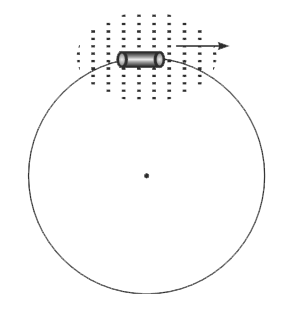A satellite in a force-free space sweeps stationary interplantary dust at a rate dMdt=βυ, where υ is the speed of escaping dust w.r.t. satellite and M is the mass of saetllite at that instant. The acceleration of satellite is
−βυ2
−βυ2/2M
−βυ2/M
−Mβ/υ2
The correct Answer is:C
When a dust comes out with speed υ w.r.t. satellite, then thrust on the satellite,
F=−υdMdt=−υ(βυ)=−βυ2
∴ Acceleration of satellite =FM=−βυ2M
Similar Questions
A satellite in force-free sweeps stationary interplanetary dust at a rate of dMdt=αv, where M is mass and v is the speed of satellite and α is a constant. The tangential acceleration of satellite is
View SolutionA spaceship in space sweeps stationary interplanetary dust . As a result , its mass increase at a rate dM(t)dt=bv2(t) , where v(t) is its instantaneous velocity . The instantaneous acceleration of the satellite is :
View Solution
Knowledge Check
A satellite in a force - free space sweeps stationary interplanetary dust at a rate dM/dt=αv, where M is the mass , vis the velocity of the satellite and α is a constant. What is the deacceleration of the satellite ?
A−2αv2MB−αv2MC−αv22MD−αv2A satellite in force free space sweeps stationary interplanetary dust at a rate of dM/dt=αv, where M is mass and v is the speed of satellite and α is a constant. The acceleration of satellite is
A−αv22MB−αv2C−2αv2MD−αv2MA satellite in a force - free space sweeps stationary interplanetary dust at a rate dM/dt=αv, where M is the mass , vis the velocity of the satellite and α is a constant. What is the deacceleration of the satellite ?
A−2αv2/MB−αv2/MC+αv2/MD−αv2
Energy of a satellite going around the earth in an elliptical orbit is given by −GMm2a where M and m are masses of the earth and the satellite respectively and 2a is the major axis of the elliptical path. A satellite is launched tangentially with a speed √3GM5R from a height h = R above the surface of the earth. Calculate its maximum distance from the centre of the earth
View SolutionTwo indentical geostationary satellite each of mass m are moving with equal speed υ in the same orbit but their sense of rotation brings them on a collision course. What will happen to the debris?
View SolutionA near surface earth satellite has cylindrical shape with cross sectional area ofs=0.5M2 and mass of M = 10 kg. It encounters dust which has density of D=1.6XX10−11KG/ms. Assume that the dust particles are at rest and they stick to the satellite’s front face on collision. Take mean density of earth to beρ=5500kg/m3Find the drag force experienced by the satelliten
 If the dust extends throughout the orbit, find the change in velocity and radius of
the circular path of the satellite in one revolution.
If the dust extends throughout the orbit, find the change in velocity and radius of
the circular path of the satellite in one revolution.
View SolutionA satellite of mass m is in an elliptical orbit around the earth. The speed of the satellite at its nearest position is (6GM)/(5r) where r is the perigee (nearest point) distance from the centre of the earth. It is desired to transfer the satellite to the circular orbit of radius equal to its apogee (farthest point) distance from the centre of the earth. The change in orbital speed required for this purpose is
View SolutionA rocket moving in free space has varying mass due to fuel exhausted dmtdt=−bv2(t) where m(t) = instantaneous mass, b = constant, v(t) = instantaneous velocity . If gases are ejected with velocity u, with respect to rocket, instantaneous acceleration of should be
View Solution
